Increasing revenue, improving customer engagement and helping customers achieve their goals remain an email marketer’s principal objectives. To reach these goals, you need a clean mailing list and optimal email deliverability.
A clean mailing list keeps email marketers on track, avoiding hiccups and diminishing blockers to successful campaigns. A shorter, verified list is far more valuable than a larger, unverified list.
It’s the best way to ensure your messages reach your customers. And since an estimated 22.5% email addresses expire every year, marketers regularly remove unsafe or invalid email addresses.
The question is: how can you have a clean mailing list? Below you’ll find 9 key methods you should employ to maintain a clean mailing list.
1. Never buy mailing lists
In other words, always build your own list. Purchased lists come with too many problems. Think of it this way: if the list you’re about to buy has great sales potential, why would anyone sell it in the first place?
When you buy an email list, you get access to the email addresses of people who haven’t given consent to receive emails from you. It can even lead to legal trouble.
Purchased lists contain a huge number of expired email addresses. When you email them, your emails will only bounce back and damage your sender reputation. These lists also have email addresses that are no longer used, meaning you will get little to no engagement.


It’s not a good idea to used purchased lists for your email marketing.
Worse still, there’s a very high probability that purchased lists will have spam traps—email addresses maintained to catch spammers. Sending emails to spam traps can have painful consequences—better stay away.
2. Keep a steady email cadence
We are not suggesting you send out emails every other day. Maintain a certain frequency that makes sense for your business. If you’ve planned to send emails every Wednesday or twice a month, stick to that.
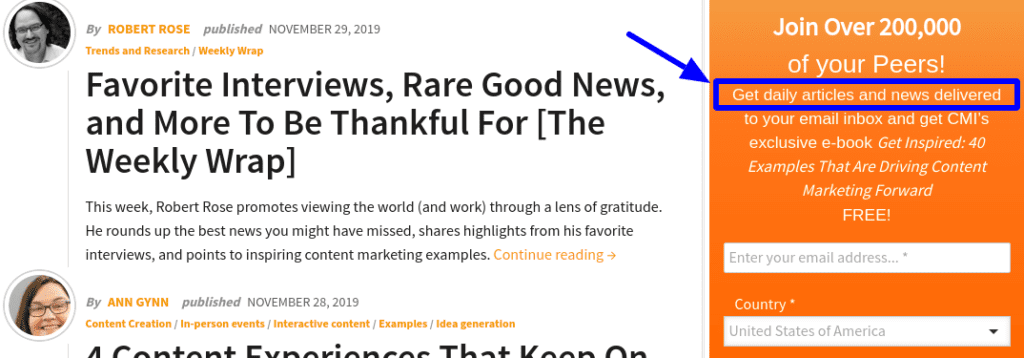

CMI makes it clear how often subscribers will receive emails.
Sending emails regularly has several benefits. For example, your brand remains top of mind for the recipient. After some time, the recipient begins expecting your emails and it leads to improved engagement.
Equally important, when an email address turns invalid, you can spot it earlier and unsubscribe it quickly. That keeps your bounce rate accurate and in check.
Alternatively, if you send emails only once or twice a year, a large number of addresses might have turned invalid in that time period. By not spotting these changes in time, you drastically increase your bounce rate and put your sender reputation at serious risk.
3. Segment intelligently
No matter how big or small your mailing list is, recipients are on different stages of the customer journey.
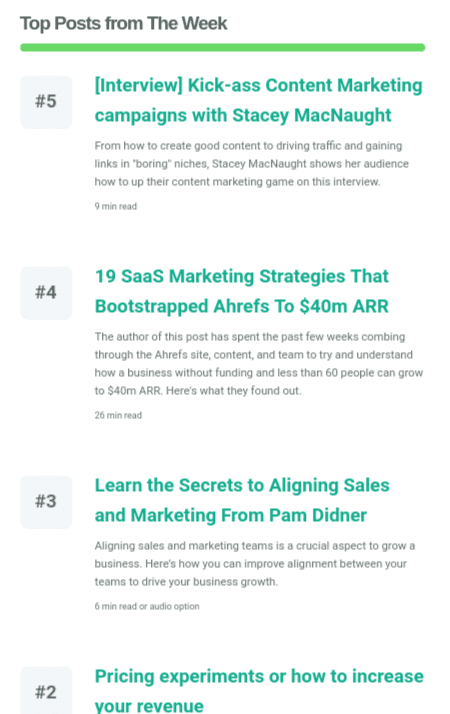

You can also segment subscribers based on the kinds of links they regularly interact with in your newsletter.
Some are just learning about your product for the first time while others know a lot more about it. And a few could be very close to making a purchase. The same message won’t work for every customer.
There are a handful of ways of finding out what your recipients want from your emails. You can send out a small survey form and segment your recipients based on their responses. You can base your segmentation on the engagement of your recent emails.
You can also segment them on the basis of what you know about them from their profile. If you haven’t asked them to build a user profile, it’ll be a good idea to ask them to create or update it. To incentivize this type of effort, you can consider giving them small rewards like a $5 coupon, free use of your tool for a week or something similar.
Never forget, segmentation is key to scaling personalization.
4. Clean your lists regularly
No matter what you do, some email addresses are going to die. People leave organizations or accept entirely different roles; start-ups are taken over and get a new domain…the reasons are endless.
One of the easiest and most highly effective ways to handle this is to clean your lists regularly. Having the right system to support a regular list cleaning, makes the whole process exponentially easier and quicker.
Opt for a reliable online email verifier tool.


A good email validation tool will break down the results of your mailing list, making it easier for you to make informed decisions.
With a GDPR-compliant verifier, you can also be sure your data will be handled in a secure manner. Cleaning your list twice a year can yield amazing returns for your email marketing efforts.
5. Track bounces
There are two main types of email bounces: soft bounces and hard bounces. A soft bounce happens for temporary reasons (e.g. a server is down, a full inbox, etc.). You can (mostly) sort it out by trying to send the email later.
A hard bounce, on the other hand, happens when the email address is incorrect or the mailbox doesn’t exist. Obviously, there’s no way you can deliver email to this address and the only thing you can do is remove the address from your mailing list.
Tracking hard bounces and removing those email addresses from your mailing list ensures you don’t send emails to these addresses again and get another bounce. A good email service provider (ESP) will be doing this automatically for you, which is one more reason to work with an ESP.
Apart from saving you money in sending costs, tracking bounces will help you maintain your sender reputation by keeping bounces within limits.
6. Send re-engagement emails
Even though you segment your recipients and send focused emails to each segment, there could be some subscribers who aren’t engaging with your emails.
For example, some of your recipients haven’t opened your last four emails. Should you take them off the list?
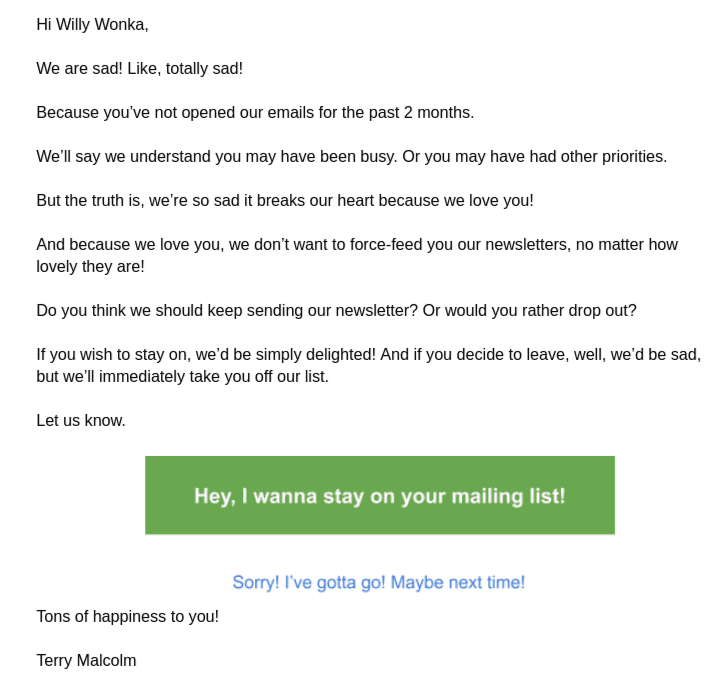

A sample re-engagement email.
It would be a serious mistake to simply remove them without understanding what’s keeping them away or giving them a chance to be heard. Otherwise, all the time and money your team may have spent in acquiring these addresses will go down the drain.
Instead, send them re-engagement emails. Let them choose a different frequency of receiving your emails. Maybe they’d prefer a monthly digest. Maybe they wish to receive only one email a month from you. Give them a choice to join your list on their terms, not yours.
You shouldn’t hold people on your mailing lists against their desires, but you must make every attempt to let them decide how and when they’d like to engage with your emails. You’ve got to respect their choices, whether they choose a monthly roundup email or whether they wish to completely opt out.
7. Use a real-time verification API
As a marketer, you do a lot of things to remove fake or expired email addresses from your database. But wouldn’t it be great if you could ensure such email addresses don’t enter your mailing list in the first place?
With a real-time email verification API, you can validate email addresses right when the users punch in the email address (hence the real time distinction). If the visitor submits an invalid address in your webform, the system will reject the address. It will also send an alert message asking the visitor to correct the address.
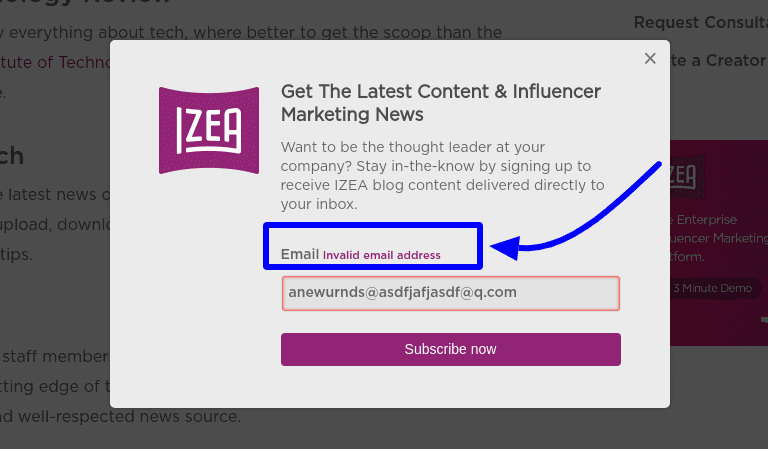

An email verification API verifies incoming email addresses in real time and lets users correct any unverified email addresses.
Apart from rejecting invalid addresses, you can also set your rules and decide, say, whether you’d like to accept role addresses (e.g. admin@domain, sales@domain), free personal email addresses (@gmail, @aol) and so on. The API will reject the ones you prefer not adding to your database.
In addition to blocking fake or poor-quality addresses, the API also helps visitors correct typos in the email address they have submitted, such as goerge@doman instead of george@domain.
8. Work with a good ESP
The best part of working with a good ESP is that you can be sure you’re following email marketing best practices.
A good ESP has your long-term interests at heart. It provides a number of guidelines for you to follow and has in place a number of rules to follow.
When you follow these rules, you begin seeing results. Some of these results are immediate, like emails going out faster due to a stronger infrastructure of the ESP. Other results are not easy to see immediately, like your sender reputation.
A good ESP will help you maintain clean email lists by making it easy to unsubscribe hard bounces, if any. It will also help you segment your list and frame re-engagement emails for recipients with negligible interaction with your brand.
9. Make it easy to unsubscribe
Sounds counter-intuitive, right? Like, why would you want to make it easy for people to leave your mailing list?
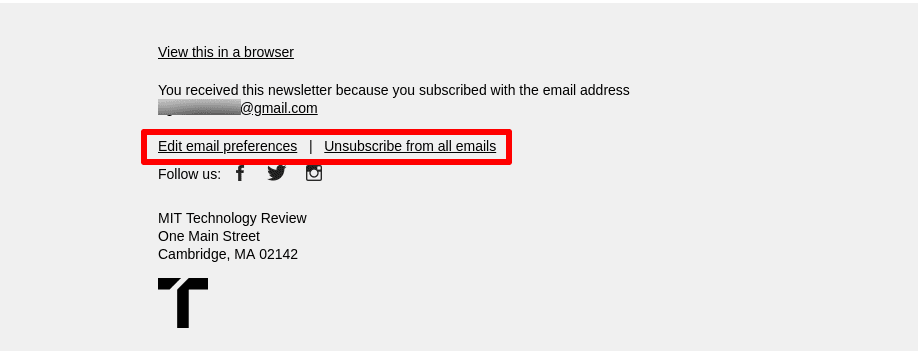

The MIT Technology Review newsletter doesn’t hide the unsubscribe link behind small fonts or light colors.
Here’s why: if you don’t make it easy for people to unsubscribe and leave your mailing list whenever they want to, it can be frustrating. And soon enough, they will mark your emails as spam or block you.
It’s natural that some people leave. Some people have simply changed priorities and no longer have any use of what you offer. Some have outgrown the need while others had wrongly landed on your mailing list in the first place.
If they are going to leave, at least make the goodbye pleasant.
Conclusion
A clean mailing list is a very important building block of your email marketing success. As this article explains, there are many ways of maintaining a clean list. It’s about finding the right mix for you and your team to achieve the greatest email marketing success.
The deliverability and email marketing experts at Iterable can help you achieve the true value of your mailing list. Contact us to set up a custom demo and understand how you can efficiently scale your growth marketing.































